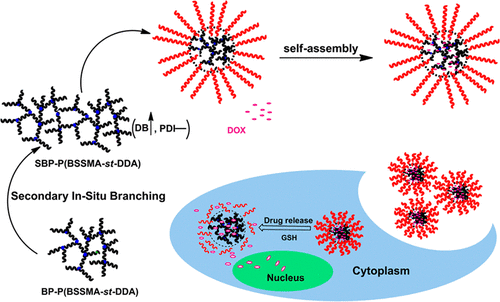当前位置:
X-MOL 学术
›
ACS Appl. Polym. Mater.
›
论文详情
Our official English website, www.x-mol.net, welcomes your feedback! (Note: you will need to create a separate account there.)
Preparation of Reduction-Sensitive Branched Block–Statistical Copolymers for Controlled Drug Release via a Secondary in Situ Branching Reaction
ACS Applied Polymer Materials ( IF 5 ) Pub Date : 2020-01-03 , DOI: 10.1021/acsapm.9b00786 Yuping Liu 1 , Guiying Kang 1 , Lu Sun 1 , Chao Meng 1 , Jinlei Peng 1 , Miao Zhang 1 , Fangjun Liu 1 , Liwei Ma 1 , Hua Wei 1
ACS Applied Polymer Materials ( IF 5 ) Pub Date : 2020-01-03 , DOI: 10.1021/acsapm.9b00786 Yuping Liu 1 , Guiying Kang 1 , Lu Sun 1 , Chao Meng 1 , Jinlei Peng 1 , Miao Zhang 1 , Fangjun Liu 1 , Liwei Ma 1 , Hua Wei 1
Affiliation

|
Branched or hyperbranched polymers with a high degree of branching (DB) and a narrow polydispersity index (PDI) are highly desirable for biomedical applications because of the significant effect of molecular weight (MW), DB, and PDI on their cytotoxicity and delivery efficiency. Although either the self-condensed vinyl polymerization (SCVP) or copolymerization with a small molecular cross-linker has been repeatedly highlighted to be an efficient strategy with respect to (hyper)branched polymers, the preparation of a (hyper)branched polymer with simultaneously a high DB and a narrow PDI has been a significant challenge because an increased DB was usually accompanied by a broad PDI. For this purpose, a reduction-sensitive branched copolymer synthesized via a reversible addition–fragmentation chain transfer (RAFT) copolymerization of a reducible monomer–initiator double-head agent, 2-((2-((2-bromo-2-methylpropanoyl)oxy)ethyl)disulfanyl)ethyl methacrylate (BSSMA), and a divinyl cross-linker, ethane-1,2-diyl diacrylate (DDA), was further reacted with a large amount of AIBN with respect to a simultaneous end-capping of RAFT thiocarbonylthio groups and a secondary in situ branching reaction of the vinyl residues, which resulted in a secondary in situ branched copolymer (SBP), SBP-poly(BSSMA-st-DDA) (SBP-P(BSSMA-st-DDA)), with an increased DB and insignificantly broadened PDI compared to the parent branched copolymer (BP), BP-poly(BSSMA-st-DDA) (BP-P(BSSMA-st-DDA)). To provide sufficient colloidal stability, SBP-P(BSSMA-st-DDA) was further used as a multi-macroinitiator to produce an amphiphilic branched block–statistical copolymer, poly(BSSMA-st-DDA)-b-poly(oligoethylene glycol methacrylate) (SBP-P(BSSMA-st-DDA)-b-POEGMA), by atom transfer radical polymerization (ATRP) of OEGMA. The resultant SBP-P(BSSMA-st-DDA)-b-POEGMA can form unimolecular core–shell micelles with enhanced stability due to the branched structure. The doxorubicin (DOX)-loaded micelles showed an intracellular reduction-promoted drug release, an efficient cellular uptake, and an inhibition of proliferation of HeLa cells. This study therefore developed a facile yet robust strategy to prepare stimuli-responsive branched polymers with a high DB and a narrow PDI for an efficient anticancer drug delivery.
中文翻译:

通过次级原位支化反应制备可控制药物释放的还原敏感性支化嵌段统计共聚物
具有高支化度(DB)和窄的多分散指数(PDI)的支化或超支化聚合物非常适合生物医学应用,因为分子量(MW),DB和PDI对其细胞毒性和递送效率具有显着影响。尽管自重乙烯基聚合(SCVP)或与小分子交联剂的共聚反应已被反复强调是针对(超支化)聚合物的有效策略,但制备(超)支化聚合物同时使用高DB和窄PDI一直是一项重大挑战,因为DB的增加通常伴随着宽PDI。以此目的,st -DDA)(SBP-P(BSSMA- st -DDA)),与母体支化共聚物(BP),BP-poly(BSSMA- st -DDA)(BP-P( BSSMA- ST -DDA))。为了提供足够的胶体稳定性,SBP-P(BSSMA- ST -DDA)进一步用作多大分子引发剂,以产生两亲性支块的统计共聚物,聚(BSSMA- ST -DDA) - b -聚(低聚乙二醇甲基丙烯酸酯)(SBP-P(BSSMA- st -DDA)-b -POEGMA),通过OEGMA的原子转移自由基聚合(ATRP)。所得的SBP-P(BSSMA- st -DDA)-b-POEGMA可以形成单分子核-壳胶束,由于其支链结构而具有增强的稳定性。载有阿霉素(DOX)的胶束显示出细胞内还原促进的药物释放,有效的细胞摄取以及对HeLa细胞增殖的抑制作用。因此,本研究开发了一种简便而稳健的策略,以制备具有高DB和窄PDI的刺激应答性支链聚合物,以有效地进行抗癌药物递送。
更新日期:2020-01-04
中文翻译:

通过次级原位支化反应制备可控制药物释放的还原敏感性支化嵌段统计共聚物
具有高支化度(DB)和窄的多分散指数(PDI)的支化或超支化聚合物非常适合生物医学应用,因为分子量(MW),DB和PDI对其细胞毒性和递送效率具有显着影响。尽管自重乙烯基聚合(SCVP)或与小分子交联剂的共聚反应已被反复强调是针对(超支化)聚合物的有效策略,但制备(超)支化聚合物同时使用高DB和窄PDI一直是一项重大挑战,因为DB的增加通常伴随着宽PDI。以此目的,st -DDA)(SBP-P(BSSMA- st -DDA)),与母体支化共聚物(BP),BP-poly(BSSMA- st -DDA)(BP-P( BSSMA- ST -DDA))。为了提供足够的胶体稳定性,SBP-P(BSSMA- ST -DDA)进一步用作多大分子引发剂,以产生两亲性支块的统计共聚物,聚(BSSMA- ST -DDA) - b -聚(低聚乙二醇甲基丙烯酸酯)(SBP-P(BSSMA- st -DDA)-b -POEGMA),通过OEGMA的原子转移自由基聚合(ATRP)。所得的SBP-P(BSSMA- st -DDA)-b-POEGMA可以形成单分子核-壳胶束,由于其支链结构而具有增强的稳定性。载有阿霉素(DOX)的胶束显示出细胞内还原促进的药物释放,有效的细胞摄取以及对HeLa细胞增殖的抑制作用。因此,本研究开发了一种简便而稳健的策略,以制备具有高DB和窄PDI的刺激应答性支链聚合物,以有效地进行抗癌药物递送。



























 京公网安备 11010802027423号
京公网安备 11010802027423号